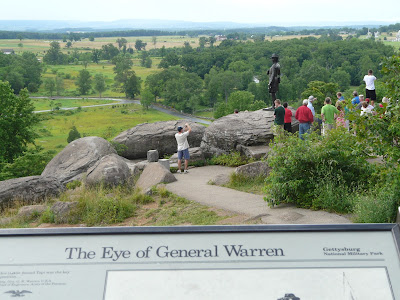 |
Cyclorama: Battle of Gettysburg |
The Battle of Gettysburg was fought July 1st
through 3rd, 150 years ago in 1863. That was where we spent most of
afternoon. The visitor center has been upgraded significantly since the last time
we were here over twenty years ago. We started with the film which illustrated
the whys and wherefores of the battle. After the film, we visited the
Cyclorama, a 360 degree painting of the third day of the battle, painted by a
French painter in the late 1800’s. The painting has spent 5 years in
restoration and the presentation has been made much more dramatic with added
scenery making a 3D effect to the painting and dramatic lighting to make the
battle seem to occur before your eyes. This was followed by the museum, which
provided a lot of the war background and with many artifacts. Finally, we took
the bus tour of the battlefield. This really helped us visualize the battle as
we could view the terrain. Much of the battlefield has been restored to what it
looked like in 1863.
General Lee was hoping to dishearten the Union by striking
in Pennsylvania rather than continuing to fight inconclusive battles in
Virginia. He was hoping to spend most of the summer here, resupplying his army
with food (remember most of the farms in Virginia had witnessed two years of
war). He had remained hidden from the
Union Army until he was seen by a Union cavalry regiment just west of
Gettysburg. General Buford wanted to hold them west of Gettysburg until
reinforcements arrived, since Gettysburg had 12 roads coming into it, making it
ideal for moving troops. They started by trying to hold Seminary Hill, but even
with reinforcements they had to fall back to Cemetery Hill, south of town by the
end of the day. From the bus tour, you could see that troops were fighting with
as little as 20 yards between the two armies. 17000 soldiers were killed,
wounded or missing that first day. During the night, more reinforcements
arrived for both armies. The Union army formed a hook formation, primarily on
the high ground, while the Confederate army was hidden in the forest opposite
the hook.
On day 2, General Lee tried to attack both flanks. The
problem was that he couldn’t tell where the end of the Union army was on the
South end. We could see how the rolling landscape hid the Southernmost portion
of the Union army from Lee’s vantage point, and he had no cavalry regiments to
scout where it was. He attacked but it turned out not to be the flank of the
formation. One of the Union generals had advanced his army out into a peach
orchard creating a bulge in the line and stretching them fairly thin. He ended up retreating, and losing 40% of his
men in the process. One of the more interesting stops on our bus tour was
Little Round Top, a rocky formation at the end of the Union line. At the start of
the battle, no one was up here, yet it had a commanding view of the entire
battlefield. The Union army managed to get troops up here, 10 minutes before
the confederate army attacked. They managed to hold the hill, ending the second
day of the battle.
 |
View from Little Round Top |
On Day 3, General Lee having failed to flank the Union army,
decided that the middle of the line must be weak, and thus that was the place
to attack. This was the site of the famed Pickett’s charge, twelve thousand men
strong. Before the charge, the confederates bombarded the union lines with 120
cannon. But the smoke was so thick, they actually fired past the union lines.
General Meade ordered the 100 Union cannon to slowly drop out, as if they had
been destroyed. Once Pickett began his charge all the cannon started cutting
down his men. Only about 200 men reached the Union lines, where hand to hand
fighting began. Once again, the Union lines held. General Lee had suffered his
first major defeat, and he ended up retreating back to Virginia.
 |
Site of Pickett's Charge |

No comments:
Post a Comment